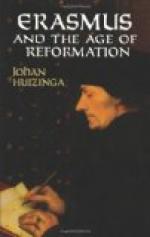One feature of life at this time which materially affected the lives of women, was the length of families and the accompanying infant mortality. It was common enough in all classes down to the middle of the last century; and it is still only too common among the poor. On the walls of churches, more especially in towns, one frequently sees tablets with long lists of children who seem to have been born only to die: and yet the parents went on their way unthinking, and content if from their annual harvest an occasional son or daughter grew up to bless them. Examples of this may be collected on every side. Cole (1467-1519), for instance, was the eldest of twenty-two sons and daughters; and by 1499 he was the only child left to his parents. His father, who was twice Lord Mayor of London, lived till 1510; the mother of this great brood survived them all, and, so far as Erasmus knew, was still living in 1521.
Another case which may be cited is that of Anthony Koberger, the celebrated Nuremberg printer, 1440-1513: and it is the more interesting, since owing to his care for genealogy, we have accurate records of his two marriages and his twenty-five children. The first marriage produced eight, born between 1470 and 1483; of these, three daughters lived to grow up and marry, but of the remaining five—including three sons, all named Anthony, a fact which tells its own tale—none reached a greater age than twelve years. In September 1491 the first wife died; and in August 1492—without observing the full year’s ’doole’—Anthony married again, the second wife being herself the sixteenth child of her parents. At first there was only disappointment; in 31/2 years four children were born and died, two of these being twins. But better times followed: of the remaining thirteen only three died as infants. Anthony the fifth and John the third, and three sons named after the three kings, Caspar, Melchior and Balthasar, were more fortunate. When 21 years had brought 17 children, the sequence ended abruptly with the death of Anthony the father; leaving, out of the 25 he had received, only 13 children to speak with his enemies in the gate.
A family Bible now in the Bodleian[31] enumerates 16 children born to the same parents in 24 years, 1550-74. One girl was married before she was 16; one son at 20 died of exposure on his way home from Holland; two reached 10, one 8, one 6. None of the remainder ten lived for one year.
[31] Biblia Latina, 1529, c. 2.
Of public morals in the special sense of the term this is not the place to speak in detail. But it may suitably be stated that sixteenth-century standards in these matters were not so high as those of the present day. ‘If gold ruste, what shal iren do?’ The highest ecclesiastical authorities were unable to check a nominally celibate priesthood from maintaining women-housekeepers who bore them families of children and were in many cases decent and respectable




